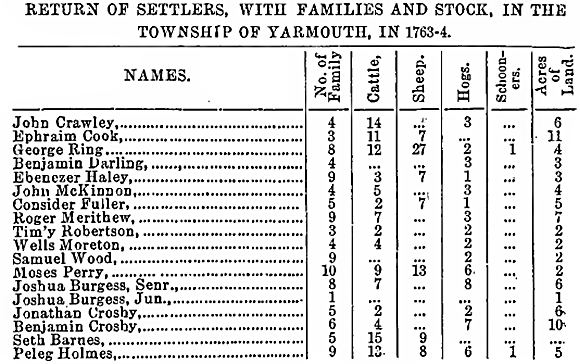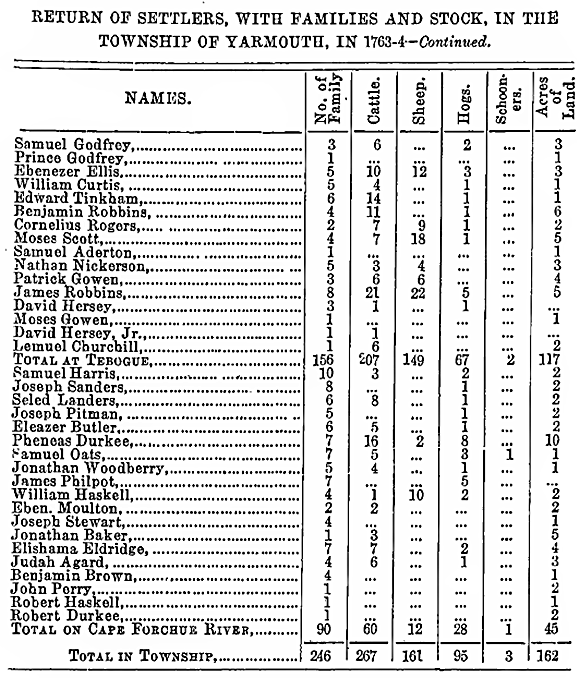|
TILL 1767, after which
land had to be bought, intending settlers continued to arrive in no
inconsiderable numbers. Nothing is plainer than that for the more part,
they were poor men; and such a misfortune as the memorable winter of
1761, which found them in the spring without food and without seed, the
suppliants of a Government who declared that “by reason of the great
load of debt due by the public, it was unable to assist them,” their
prospect was one of hard toil. To this however, results have shown they
were equal.
In the season of 1763, the settlement was increased by the arrival of
several families. Prominent among those, in respect of their numerous
descendants, were Cornelius Rogers, Peleg Holmes, Jonathan Utley,
Eleazer Hibbard, Eleazer Butler, William and Robert Haskell, Benjamin
Robbins, Benj. Crosby, Lemuel Churchill, Levi Horton, and David Hersey.
A glance at the Christian names shows us the former home and extraction
of all of them ; whilst a moment’s reflection on the Surnames most
widely scattered over the County, will satisfy us of the after
^importance of this season’s immigration.
The Committee for laying out lands were kept busily employed in
providing for the present, and looking out for the future. One of the
schemes they had was a Town of lesser importance on the Forehue Harbour,
than that which was projected on the Chehogue harbour, a scheme tcf
which we have already referred. They intended to locate the principal
Town on the projecting land, east of the burying ground on the Chebogue
harbour; and the spot is still known by the name of the Toivn point.
Here they had settled the site of the Town. The proceeding was
reasonable; for at this time, and for many years afterwards, Chebogue
was the centre of population and influence.
Simultaneously with the arrival of English inhabitants in Yarmouth, some
few persons had arrived in the future districts of
ARGYLE AND PDBNICO.
There was no difficulty in this part of the County about grants; no
grant of the whole of what is known as the Township of Argyle having
ever been made. The earliest record we have of any settlers is, “An
application from William Ingols on behalf of several persons who are
arrived at Pugnico (Pubnico), and requesting that a small quantity of
land may be allotted to them, as the Town lots are not yet laid out. The
Committee did advise that ten acres of land be laid out to each family
now on the spot as well as t'o those families which shall hereafter
arrive there.” There are no means of ascertaining 'exactly who those
several persons were, no list or record of any kind having been
preserved. Whether Mr. Ingols had taken more than belonged to him, when
he spoke for himself and the “several others,” it is impossible to say;
but a few months later, the Council ordered Francis Salter be
accommodated with a first lot at Pugnico, which is to be laid out to
him, of the cleared lands enclosed there by Mr. Ingols; and also that
ten acres of land be laid out to the said Francis Salter -at Pugnico,
agreeable to the order of Council of the first day of May last, the said
ten acres to be laid out to him, wherever he chooses, so as the same
does not interfere with the persons already settled there.”
By the year 1768,
“John Frost and fifteen others settled on Abuptick River.
“They have about sixty-four in family, sixty-five cattle, thirty sheep,
twenty hogs, one schooneiy twenty-five acres of cleared land, two
hundred and five acres of land cleared from the woods by the
inhabitants, and most of it planted with potatoes and planted with
grain.”
Such is the detailed history of what was shortly afterwards called
Argyle. That name, by which eventually the whole Township or district
became known, was given by Captain Ranald McKinnon, a native of the
Western Highlands of Scotland, who had served in the regular army with
distinction, and afterwards in this Province, with energy, in completing
the expulsion of the French. In consideration of his services, on the
first of April, 1766, he had two thousand acres granted to him,
comprising “a tract of land where he now lives, being a point of land
between the Island Nonparison and Eel Bay and the river Abuptic,
containing five hundred acres. Also, the Island or Islands called La
Tour, lying between the Island called Nonparison, granted to Messrs.
Crawley and Morris, and the Island called Long Island granted to H. E.
the Governor, containing one thousand acres.”
Captain McKinnon had a large family of sons and daughters, though few,
if any, of their descendants bearing the name are now in the county. One
of his sons, Major John McKinnon, was member for the County of Shelburne
in 1828. And one of his daughters, afterwards the wife of Dr. Fletcher,
an army physician, was well known in her day for her literary ability.
On his arrival about 1762, he first settled on Amirault’s Hill, between
two and three miles below Tusket village. But there were neither French
nor English neighbours there at that time, and in a year or two he
removed to the charming spot known as Oak Grove. In both cases, he
proved himself a true highlander, for he chose the most elevated sites
in the neighbourhood.
The scenery in this locality is marked by uncommon and varied beauty,
which opens to the traveller as he winds round the road and is about to
cross the Argyle bridge, looking westward. In the foreground are the
bridge over the quietly flowing and winding river, with one or two
cottages half hidden by the foliage; and in the background the hills
successive rise till their summits are crowned with lofty trees; through
the opening branches of which, near the close of an autumn day, the
western sun’s rays are poured, filling the scene with lights and shadows
of ever-varying depth. A climb among the still standing oaks to the top
of the hill on which once stood the old McKinnon homestead, will well
repay the labour. There is little now to tell the tale of bygone days,
save the debris of the old cellar wall, in the vicinity of which a lilac
or two, an old thorn, and a few willows, still stand. All that is merely
human is gone; the view as of yore remains; and like him who made it, it
is very good. Around you are the neighbouring hills, but you are on the
highest; and at the base of the hill,, looking southward, is the main
river, studded with numerous islands, breaking up its course. On all
sides, the view is made delightful by a most pleasant diversity of wood
and water, hill and dale.
It will have been borne in mind that one of the Regulations of Council
of 1761, required the Committee laying out lands, to make a return of
all the settlers at an early day. Accordingly, in the month of June,
1764, just three years after the first landing, a return was made to
Halifax, by John Crawley. It is much too interesting a paper to pass
over. It is
THE FIRST PUBLIC RETURN; and is here inserted whole :—

This return is accompanied by the rough
calculation before given of the probable number of persons in Argyle;
Mr. Crawley saying that “the distance prevented a particular return in
time.”
It is a very curious circumstance, that this return omits the names of
several persons of whom we have proof that they were here at the time
the return was made. John Richardson, Andrew Durkee, Levi Horton,
Eleazer Hibbard are all omitted. By some curious accident, even the name
of Josiah Beal, with whom Mr. Crawley must have had, as an active member
of Committee, continued intercourse, is left out. It will be seen by
this return that Tebogue, as it is called, was a place of twice greater
importance than Cape Forchue, The names of several persons here
mentioned suggest this as the most fitting place for A FEW BRIEF
PERSONAL DETAILS.

It will be seen, on glancing at Mr.
Crawley’s list, that several were young men, little more than minors;
and that others had considerable establishments. Thus, George Bing had a
family of eight; and as we have already seen that he owned a fishing
vessel and employed men, this may acoount for it.
John McKinnon settled at Chebogue Point. He was a brother of Captain
Ranald at Argyle; having served the Government, he was rewarded with
large grants of land in the Township. Altogether he had 2664 acres. He
and his wife were drowned in the Grand Tusket sluice while on their way
to visit his brother at Argyle. His descendants are scattered throughout
the County.
Cornelius Rogers, whose descendants are also numerous, was in all
probability a direct descendant of John Rogers who suffered at
Smithfield. The connexion is traceable between Cornelius and his
ancestors, who came over in the “Mayflower.”
William Curtis, who came from Marblehead, built his house near the site
of the new poor-house. He was an original grantee; and, as if “coming
events cast their shadows before,” having been robbed of his property by
a lawyer named Prout who lived at Murphy’s Bridge, he became for many
years a charge upon the Town. Prout was handled in the way, as the story
has it, that they do sailors who for the first time cross the line.
Moses Scott was a brother of the Rev. Jonathan Scott, for many years the
Congregational minister in Chebogue. His descendants are as numerous as
for the more part they are prosperous.
David Hersey, or as it afterwards became corrupted, Has-sey, lived near
to Ephraim Cook, who built a saw and a grist mill, the former of which
was managed by Hassey; and was long afterwards known as “Hassey’s mill.”
James Brown’s descendants are quite numerous, although the family name
is extinct. He came from Ipswich, Mass., in the year 1767.
With regard to John Crawley, who made the return, little of his
antecedents is known before he came to Yarmouth in the spring of 1762.
He had a brother and nephew who were both grantees, who came here after
him, but who did not remain long. Whether Edmund and Joseph Crawley, who
obtained grants on Nonparison in 1763, were relatives, near or distant,
has not been satisfactorily established. Mr. Crawley was the first
acting Justice, and the first Custos in this Township. He was a man
superior to the general run of the settlers in business ability. He was
appointed by the Council one of the Committee for settling the Township,
and he was constantly engaged, one way or another, in public affairs. He
frequently served on Committees for examining Town matters, and
generally presided at public meetings. He also acted as Judge of Common
Pleas until his death in 1807. He was twice married. By the latter
marriage, which was very late in life, he had two sons, one of whom is
our respected townsman of the same name, who is also, I believe, the
only living male representative of the second generation in the Township
of Yarmouth. |
